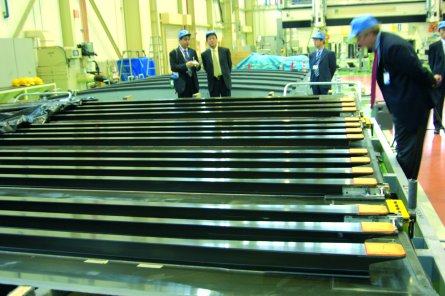Fuji Heavy Industries (FHI) completed work on the first production composite lower-skin section for the Boeing 787 on 12 June in preparation for the start of final assembly of the centre wing box, scheduled for 27 June and marking the starting point for the manufacture of the first aircraft.
“Our part is the first and has the highest loads,” says FHI 787 programme manager Yasuhiro Toi, who adds that the wing box is “similar overall” to conventional metallic alloy-based structures, but that “the detail is more sophisticated” to take advantage of composite materials with tailor-made thicknesses to provide strength where needed. Measuring 5.3 x 5.8m (17.4 x 19ft), the initial lower skin will be followed within a week by the upper skin. The wing box, or Section 11, will be integrated with a Kawasaki Heavy Industries-built main landing gear wheel well unit to make the first Section 11/45 in December and is expected to be shipped to Boeing in January 2007.
|
|---|
| FHI has completed the centre wingbox lower skin for the first 787. |
Meanwhile, Boeing is scrambling to catch up on preparations for certification by building two new composite fuselage test barrels to replace the flawed unit that failed an inspection test in May. The problem “has nothing to do with the barrels themselves”, says 787 vice-president and general manager Mike Bair. The problems stemmed from a relatively late attempt to use a lighter, composite mandrel in the critical automated high-speed tape lay-up tool in place of the standard, Invar metal mandrel. During the tests the mandrel “expanded too much, and rather than redo it, we sent it back to the machine shop”, says Bair. Attempts were made to fix the imperfect mandrel, but leak paths opened up, resulting in the porosity problem discovered during later non-destructive testing.
Source: Flight International




















